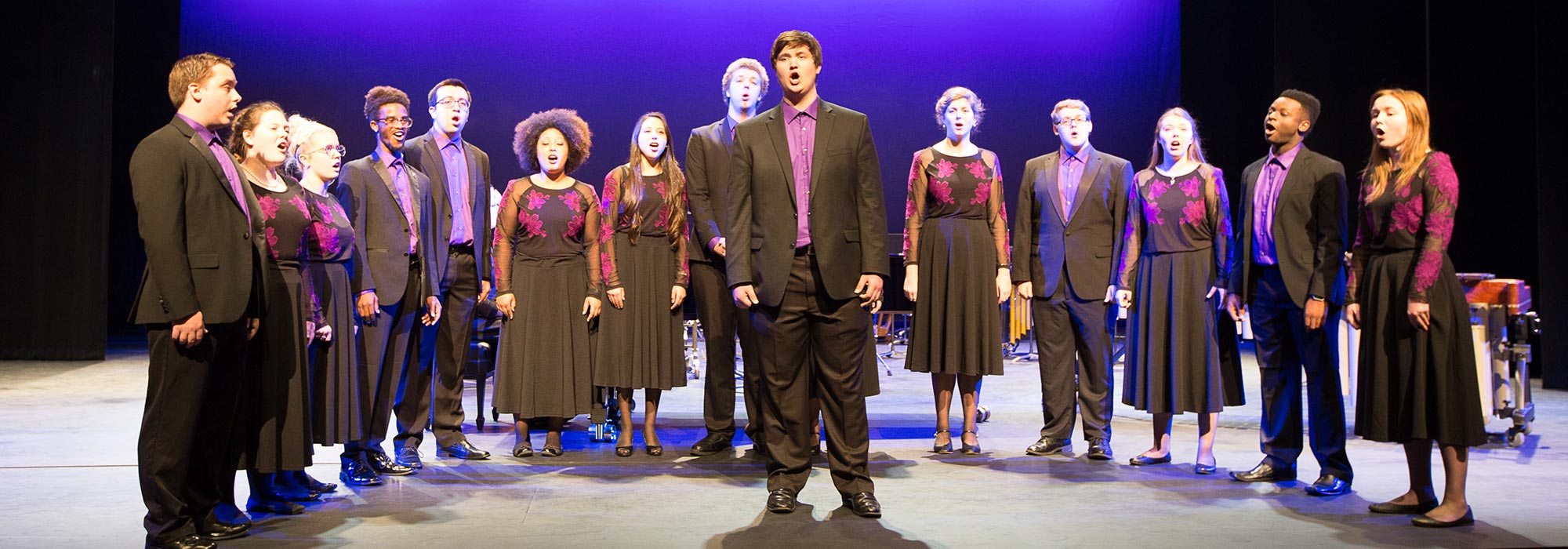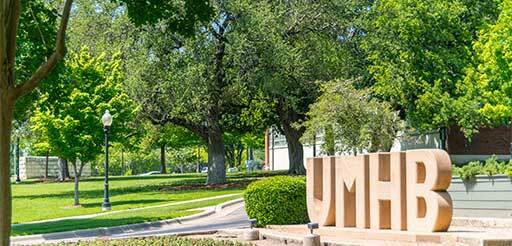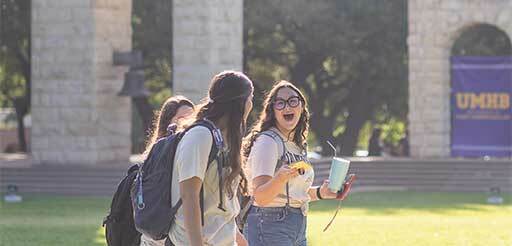Statement of Artistic Expression
The Study of Fine Arts and Its Expression on the Christian Campus
Most, if not all, Christian liberal education institutions of higher learning include the study of the arts and humanities within their respective curricula. The University of Mary Hardin-Baylor is no exception, requiring at least three semester hours of fine arts study in all of its baccalaureate degrees. The College of Fine Arts--departments of art, communication and dramatic arts, and music--is the primary engine for the study of the arts, their presentation and performance at the university.
To form the mind, to stretch the understanding, to sharpen intellectual powers, to enlarge the vision, to cultivate the imagination and impart a sense of the whole--this is the task of liberal education and the study of the liberal arts. The study and practice of artistic expression is crucial to the goal of holistic education. Four of our ten Institutional Goals relate directly or indirectly to the study of liberal and fine arts--“learning from beauty.”
The Arts in Biblical and Theological Perspectives
The Bible is overwhelmingly (though not exclusively) a work of literature and, as such, expresses truths through story, poem, vision, and letter--all artistic media. It is further apparent that Jesus and the writers of the Bible trusted literary forms to express religious truth, and even found it impossible to communicate the truth of God without using literary artistic discourse. The Bible endorses the arts in principle and, from its pages we learn that music, literature, and visual art are meant to be a central ingredient in the worship of God. The biblical doctrine that humans are created in the image of God is the theological reason why people write literature and paint pictures and compose music. They create because they have been endowed with God’s image. But the arts also permeate all life. Corresponding to this breadth is the fact that in the Bible there is no prescribed style or content for art. God-glorifying arts can be realistic or fantastic, representational or symbolic or abstract. Artistic creativity and beauty are the gifts of God. Their function is to glorify God and refresh people. Like other gifts, they can be misused and redirected from their God-given purpose. The biblical perspective toward the arts, therefore, steers artistic expression and creativity toward ultimate truth, beauty, and goodness.
Human imagination has its unique way of expressing truth and reality. It uses a language of concrete images and sensations to capture a sense of life and human experience. The world of the artistic imagination is essentially fictional. It is an imaginary world governed by conventions that only partly correspond to things in real life. In works of art, we find the materials of life simplified, rearranged, and heightened. Despite the objectionable qualities present in some art, they nevertheless illuminate life as we know it. Works of art are a window to reality. Like a lens that distorts in order to enable us to see something more clearly, the artistic imagination creates imaginary worlds that allow us to see reality with heightened clarity.
Art inevitably involves the perspectives of both artist and audience. The subject matter that artists choose indicates what they regard as real and significant. Works of art also embody the artist’s interpretation of the subject matter that is portrayed. Readers, listeners, and viewers assimilate works of art in terms of their own experiences and world view. Christians should complete their assessment of works of art by scrutinizing them with explicit ethical and theological standards. The presence of Christian elements in art is not primarily a matter of style, form, or subject matter; it is rather in the perspective that an artist brings to the work. There is a range of ways in which a work of art can embody Christian viewpoints or intersect with the Christian faith. Such levels of interaction with Christianity may, but not necessarily, include the use of Christian allusions and symbols, the embodiment of inclusively Christian themes, and the expression of exclusively Christian concepts.
There is some content in visual art, music, theatre, and literature that is hostile to Christianity. Such trends as the idolizing of art, the isolation of the artist from ordinary life, nihilism, the revolt against form and beauty, and the assault on Christian morality are ultimately alien to Christian standards, whatever occasional truth one might find in works of this type. While never relinquishing their own standards of truth, beauty, and morality, Christians should take such art seriously as an expression of the prevailing values and attitudes in current culture. Much of what ideally happens when students and audiences have contact with the arts can be summed up in the formula that works of art encourage us to have good responses—to human life in the world, to our surrounding culture, to God, to truth, to beauty. “Doing art” is not limited to the work of writers, composers, and artists. It also includes the creative participation of readers, listeners, and viewers in a process of experience—encounter, discovery, recognition, self-revelation, and interpretation.
Not only Christians but all of humanity needs the arts. The arts enhance our sense of the richness of human life. They can activate us to thought and feeling. And at their best, they refresh us and direct us to the ultimate source of truth, good, and beauty—God.
The Arts in Christian Higher Education
An excellent education should provide for the student greater knowledge of God’s world, the cultivation of talents and skills, and the development of moral and aesthetic sensibilities. The arts fulfill all three of these areas. Students who participate in the arts are exposed to the history of art, music, theater, dance, and literature and they learn how various cultures have expressed themselves in these forms in history, thereby increasing their knowledge of the world. Across cultures and throughout time, the arts have communicated the most significant values of the cultures that produced them. In order to understand any culture, one must understand its art. Therefore, we are committed to the critical study of the full range of visual art, performing art, and literary art.
The arts also provide an opportunity for students to cultivate their talents and skills through creative expression. As creatures made in God’s image (Genesis 1: 26-27), humans image God when we use our God-given imaginations to create works of art and when we participate in those works to the glory of God. We are committed to the idea that it is our Christian responsibility to provide opportunities for our students to bring their own creative abilities to fulfillment through the arts.
The arts offer a wonderful opportunity to develop aesthetic and moral sensibilities. Students exposed to great painting, sculpture, music, drama, and literature grow in their appreciation of human excellence, and they develop their own aesthetic sensibilities. To be exposed to art, however, is to be challenged. As do all other disciplines on campus, the arts should broaden our horizons, increase our insight, sharpen our intellects, reveal new areas of interest, and refine our ability to appreciate the good and the beautiful. In order to accomplish these tasks, art often challenges our preconceived understandings and assumptions, not in order to destroy those received beliefs, but so that they might be more critically appropriated. The over-arching goal of the arts is to reveal truth, and our Christian commitments bring us to the conclusion that all truth is ultimately redemptive. This does not mean, however, that such truth is devoid of hardship, conflict, cruelty, struggle, or behavior that we might find objectionable. In order to reveal truth, the arts sometimes use images, words, sounds, or actions that, by themselves, we would find offensive. However, within the broader context of the work itself and how that work is presented, we believe such works can serve an educational purpose. The arts can reveal truth from both a positive and a negative perspective.
When the University presents a work of art, whether in the concert hall, the classroom, the theater, or the gallery, that some may find offensive, it should be noted that sponsoring such works does not imply endorsement of every aspect of the work’s content. The Scriptures (I Corinthians 10:23) reveal that all things are lawful, but they are not necessarily always profitable or edifying. Consequently, faculty (artists) should choose content with the particular constituency in mind. Regardless, any work of art that may be offensive in various ways may be used to further truth if presented in the proper context; the University will take special care to balance freedom of expression and our responsibility to promote the religious standards of the institution, while upholding the highest standards of artistic integrity.
God created the human capacity for communication through the arts and He empowered us to be creatively expressive. For that reason, the arts must be a necessary part of Christian education.
Accepted by President’s Council • October 4, 2005
Page last updated September 27, 2018



